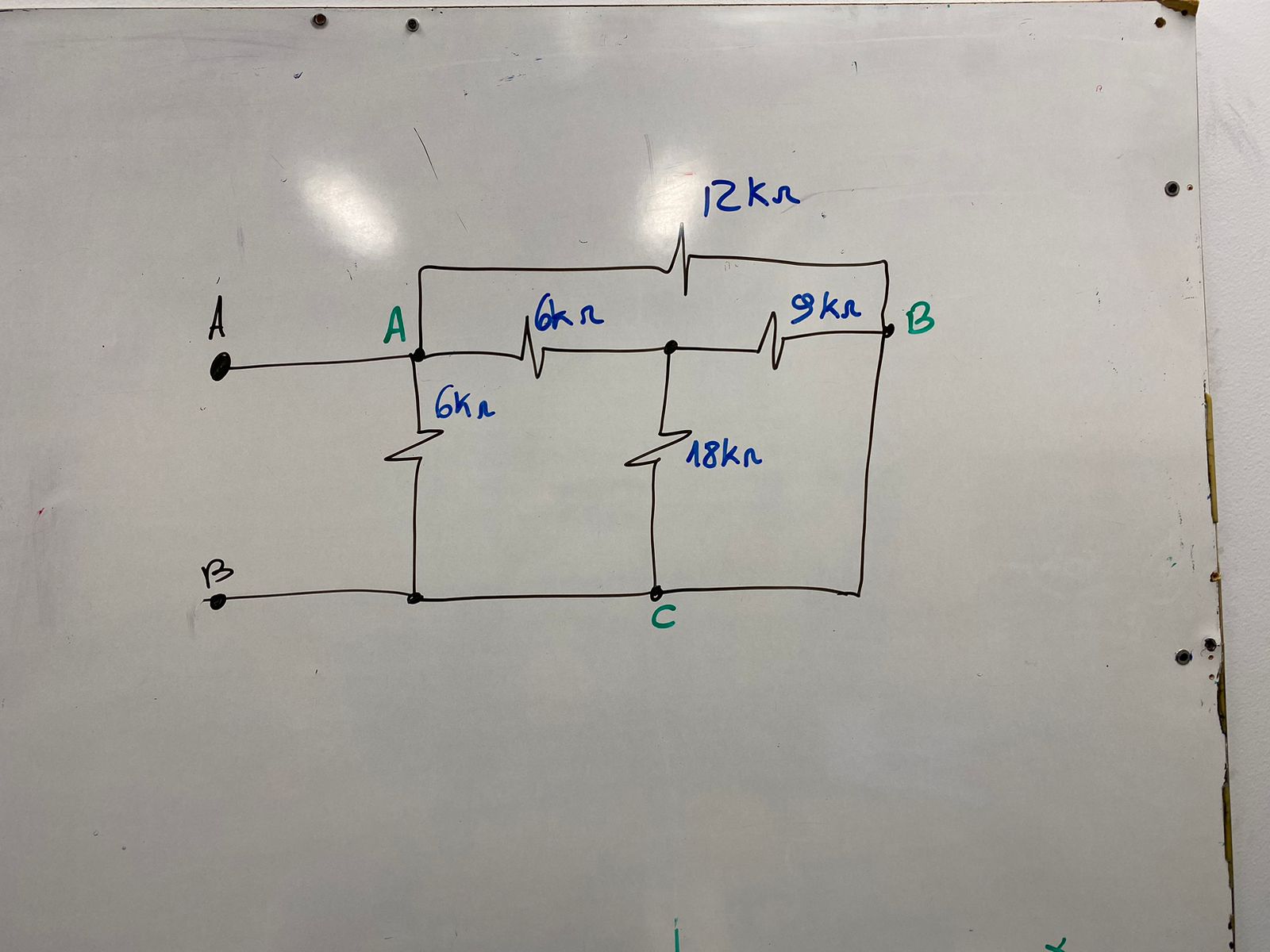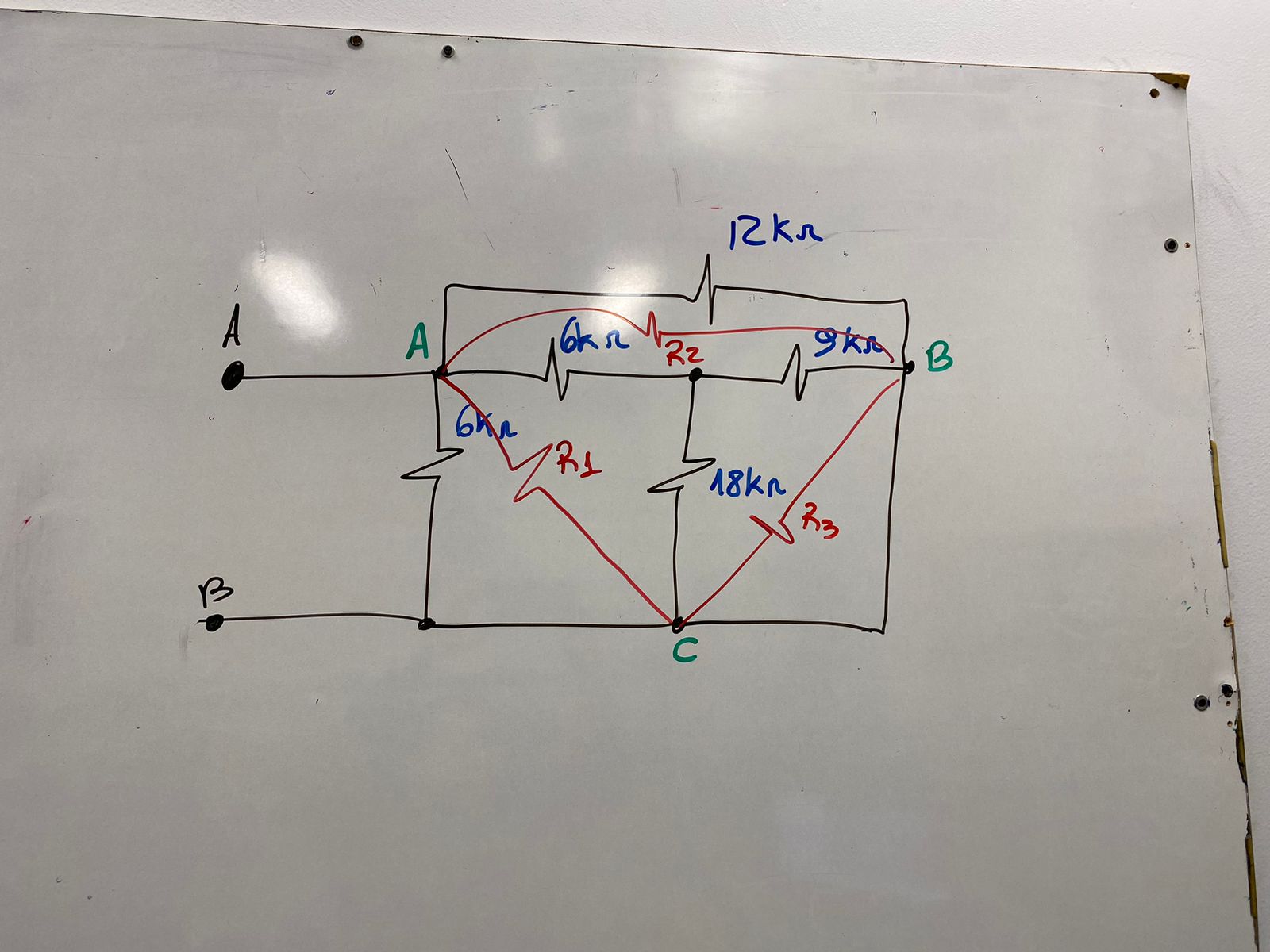[ESP/ENG]📚 De Triángulo a Estrella: Guía Completa y Ejemplos Prácticos ✨ parte 13 | 📚 From Triangle to Star: Complete Guide and Practical Examples ✨ part 13
[ESP]
🔌 ¡Bienvenidos a una nueva publicacion de nuestro Curso de Circuitos Eléctricos! 🔋
Hola a todos 👋, en el post de hoy continuaremos con nuestro análisis de circuitos eléctricos. Antes de pasar a los divisores de voltaje y corriente, quiero mostrarles un ejercicio más sobre resistencias conectadas en triángulo y estrella para realizar la transformación. 🚀
En el post anterior (que pueden ver aquí) aprendimos a trasformar un circuito de resistencias de estrella a triangulo y viceversa y hoy lo vamos a aplicar a un ejercicio real donde ni la ley de Ohm ni la ley de Kirchhoff nos permiten resolver circuitos mixtos de resistencias. ¡Comencemos! 🌟
✨Evaluacion del circuito a resolver ✨
🔧 Circuito Principal
En el circuito anterior, aprendimos a identificar que, según lo visto en el post aterior , las resistencias R 1, R 2 y R 3 están conectadas en estrella. En esta configuración, no podemos aplicar las leyes previamente estudiadas, como mencionamos en la introducción. Por lo tanto, para poder aplicar estas leyes y obtener la resistencia total del circuito entre los bornes A y B, tendremos que transformar esta conexión en estrella a una conexión en triángulo.
En resumen, tenemos resistencias conectadas en una configuración estrella (Y). Vamos a transformarlas a una configuración triángulo (Δ). Esto nos permitirá simplificar el circuito y obtener el mismo resultado de resistencia equivalente que al aplicar solo serie y paralelo.
Configuracion estrella:
- Resistencia R 1= 6 kΩ
- Resistencia R 2 = 18 kΩ
- Resistencia R 3= 9 kΩ
🎯 Ejemplo Práctico
Para transformar de estrella a triángulo, utilizamos las siguientes fórmulas:

Aplicamos estas fórmulas para encontrar los valores de las resistencias en la configuración triángulo:

Ahora que tenemos las resistencias en la configuración triángulo, vamos a redibujar el circuito. 🎨
Simplificación de Resistencias en Paralelo:
- Resistencia 1 (36 kΩ) en paralelo con Resistencia 2 (18 kΩ):

Determinar la Resistencia Equivalente Total
Finalmente, simplificamos el circuito para encontrar la resistencia equivalente total entre los terminales A y B.
- Resistencia 1 en paralelo con Resistencia 3:

Así, hemos demostrado que tanto aplicando las transformaciones de estrella a triángulo como utilizando solo serie y paralelo, el resultado de la resistencia equivalente es el mismo: 3 kΩ. ✅
🚀 Ventajas de Estas Transformaciones
- Flexibilidad en el Diseño del Circuito: Permiten simplificar el análisis y diseño de circuitos complejos.
- Reducción de Errores: Facilitan la verificación de resultados a través de métodos diferentes.
- Ahorro de Tiempo: Simplifican cálculos, especialmente en circuitos grandes y complejos.
- Optimización: Ayudan a identificar configuraciones más eficientes y efectivas.
🔧 Conclusión y Próximos Pasos
Con estas herramientas, estamos listos para resolver circuitos más complejos y optimizar nuestros diseños. En el siguiente video, analizaremos los divisores de voltaje y corriente, y resolveremos ejercicios prácticos aplicando las leyes de Kirchhoff y otros métodos avanzados. 📊🔍
📢 ¡Gracias por Leer! Mantente Conectado para Más Contenido Educativo 📚
Espero que este post te haya sido útil. Si fue así, no olvides dejar un comentario y compartir tus pensamientos o preguntas. 📝
🔔 No te pierdas mis próximas publicaciones donde seguiremos explorando el fascinante mundo de la electrónica y los circuitos. Cada semana, voy a traer nuevos temas, ejemplos prácticos y recursos para que sigas aprendiendo y mejorando tus habilidades.
🤝 Seguime en mis redes sociales, donde podrás conectarte con otros entusiastas de la electrónica, hacer preguntas y recibir ayuda en tiempo real. ¡Estamos aquí para ayudarte!
📷 Comparte tus Proyectos: Si has aplicado estos conocimientos en tus propios proyectos, ¡nos encantaría verlos! Comparte tus avances y aprende de otros en nuestra comunidad.
🌟 Mantente en Contacto: Sígueme en mis redes sociales para actualizaciones, contenido exclusivo y más consejos sobre electrónica y circuitos. Tu participación y apoyo son lo que hace que esta comunidad crezca y se enriquezca.
¡Nos estamos leyendo! Hasta entonces, sigue explorando, aprendiendo y compartiendo. ¡Juntos, hacemos la electrónica más accesible y emocionante para todos! 🚀✨
🤝 Follow me on my social networks, where you can connect with other electronics enthusiasts, ask questions and receive help in real time. We are here to help you!
📷 Share your Projects: If you have applied this knowledge in your own projects, we would love to see them! Share your progress and learn from others in our community.
🌟 Stay in Touch: Follow me on my social media for updates, exclusive content and more tips on electronics and circuits . Your participation and support are what make this community grow and enrich.
We are reading each other! Until then, keep exploring, learning and sharing. Together, we make electronics more accessible and exciting for everyone! 🚀✨
[ENG]
🔌 Welcome to a new publication of our Electrical Circuits Course! 🔋
Hello everyone 👋, in today's post we will continue with our analysis of electrical circuits. Before moving on to voltage and current dividers, I want to show you one more exercise on resistors connected in delta and star to perform the transformation. 🚀
In the previous post which you can see here we learned to transform a resistor circuit from star to triangle and vice versa and today we are going to apply it to a real exercise where not even Ohm's law nor the Kirchhoff's law allow us to solve mixed resistance circuits. Let's get started! 🌟
✨Evaluation of the circuit to be solved ✨
🔧 Main Circuit
In the previous circuit, we learned to identify that, as seen in the previous post, the resistors R 1, R 2 and R 3 are connected in a star. In this configuration, we cannot apply the laws previously studied, as we mentioned in the introduction. Therefore, in order to apply these laws and obtain the total resistance of the circuit between terminals A and B, we will have to transform this star connection into a delta connection.
In short, we have resistors connected in a star (Y) configuration. Let's transform them to a triangle configuration (Δ). This will allow us to simplify the circuit and obtain the same equivalent resistance result as when applying only series and parallel.
Star configuration:
- Resistance R 1= 6 kΩ
- Resistance R 2 = 18 kΩ
- Resistance R 3= 9 kΩ
🎯 Practical Example
To transform from star to triangle, we use the following formulas:

We apply these formulas to find the values of the resistances in the triangle configuration:

Now that we have the resistors in the triangle configuration, let's redraw the circuit. 🎨
Simplification of Resistors in Parallel:
- Resistor 1 (36 kΩ) in parallel with Resistor 2 (18 kΩ):

Determine Total Equivalent Resistance
Finally, we simplify the circuit to find the total equivalent resistance between terminals A and B.
- Resistor 1 in parallel with Resistor 3:

Thus, we have shown that both applying the star-to-delta transformations and using only series and parallel, the result of the equivalent resistance is the same: 3 kΩ. ✅
🚀 Advantages of These Transformations
- Flexibility in Circuit Design: They allow you to simplify the analysis and design of complex circuits.
- Error Reduction: They facilitate the verification of results through different methods.
- Time Savings: They simplify calculations, especially in large and complex circuits.
- Optimization: They help identify more efficient and effective configurations.
🔧 Conclusion and Next Steps
With these tools, we are ready to solve more complex circuits and optimize our designs. In the following video, we will analyze voltage and current dividers, and solve practical exercises applying Kirchhoff's laws and other advanced methods. 📊🔍
📢 Thanks for reading! Stay Connected for More Educational Content 📚
I hope this post has been useful to you. If so, don't forget to leave a comment and share your thoughts or questions. 📝
🔔 Don't miss my next posts where we will continue exploring the fascinating world of electronics and circuits. Each week, I'll bring new topics, practical examples, and resources to keep you learning and improving your skills.
🤝 Follow me on my social networks, where you can connect with other electronics enthusiasts, ask questions and receive help in real time. We are here to help you!
📷 Share your Projects: If you have applied this knowledge in your own projects, we would love to see them! Share your progress and learn from others in our community.
🌟 Stay in Touch: Follow me on my social media for updates, exclusive content and more tips on electronics and circuits . Your participation and support are what make this community grow and enrich.
We are reading each other! Until then, keep exploring, learning and sharing. Together, we make electronics more accessible and exciting for everyone! 🚀✨


Congratulations @profwhitetower! You have completed the following achievement on the Hive blockchain And have been rewarded with New badge(s)
Your next target is to reach 1500 upvotes.
You can view your badges on your board and compare yourself to others in the Ranking
If you no longer want to receive notifications, reply to this comment with the word
STOPCheck out our last posts:
Greetings @profwhitetower ,
Another excellent post regarding electronics...and yes I do believe you are making electronics more accessible, understandable and interesting for everyone! Well done! ^__^
Kind Regards,
Bleujay
Thank you, Thank you for the repost of Bleujay's Principle of the Day.
I am very happy to be able to facilitate entry into this beautiful world of electronics, we all help each other!!!
Thanks for your contribution to the STEMsocial community. Feel free to join us on discord to get to know the rest of us!
Please consider delegating to the @stemsocial account (85% of the curation rewards are returned).
You may also include @stemsocial as a beneficiary of the rewards of this post to get a stronger support.
Gracias por seguir apoyando mi contenido comunidad!!! Ah seguir 🙏🏻🥹
Ame las mallas por allá en el 2000, pero ya hoy no hago ni una conversión... Solo quedo plasmado en mi título
Es una materia en que tengo que repasar conceptos, muy útil la publicación, así que voy a guardarla y a restregarme las neuronas un poco.
Siempre es bueno tener la teoría de los circuitos presente.
Keep up the good work. 👏
Recognized by Mystic artist Gudasol
You are loved.
Interested to to help music map cXc.world spread more good vibes on Hive?.